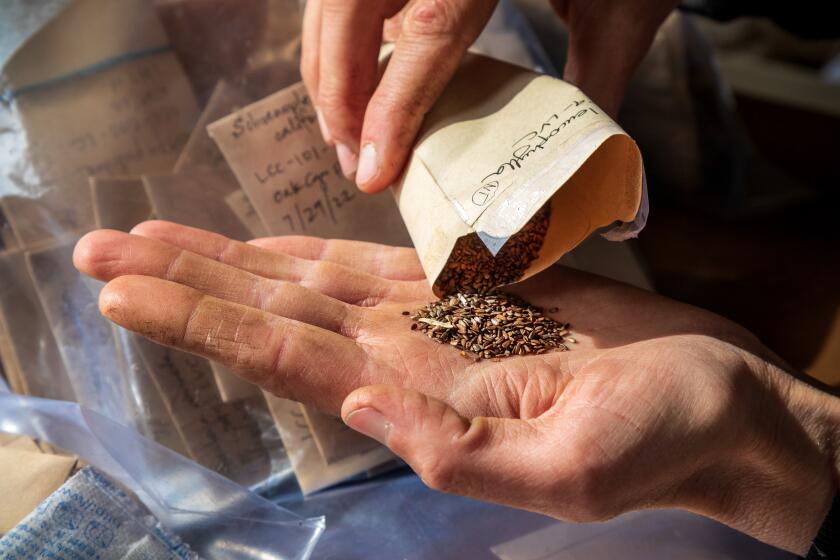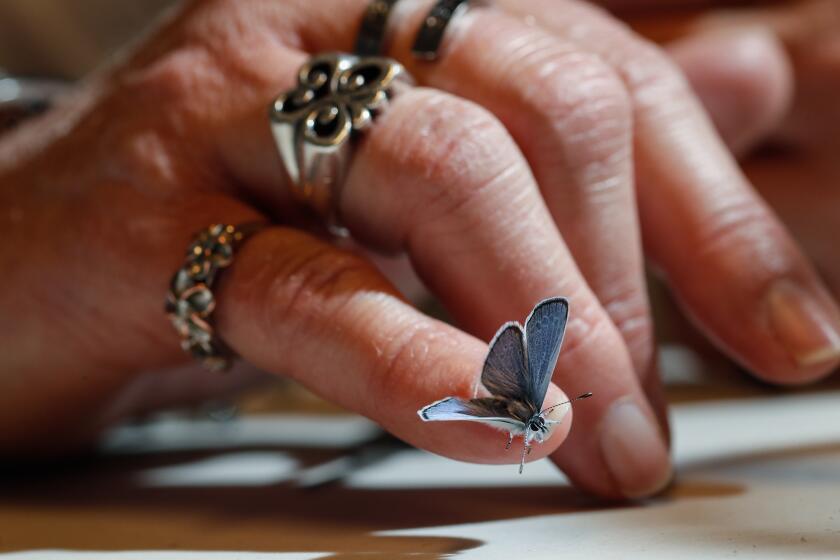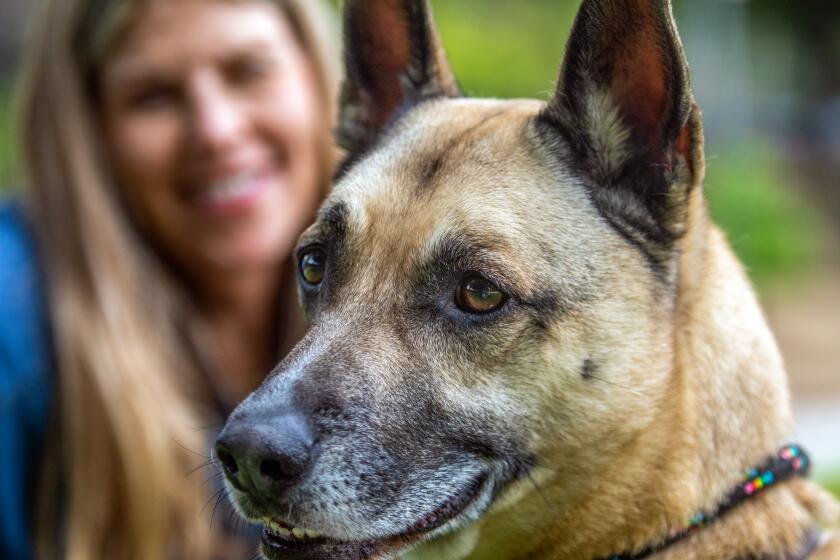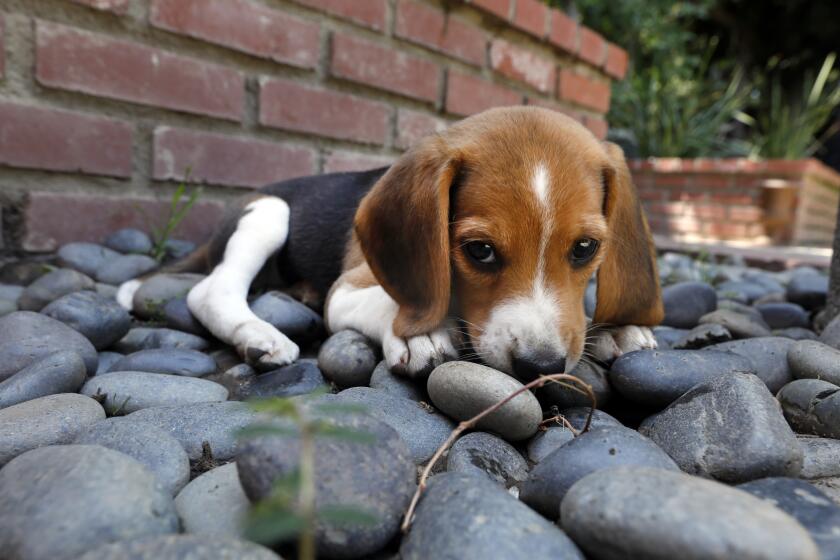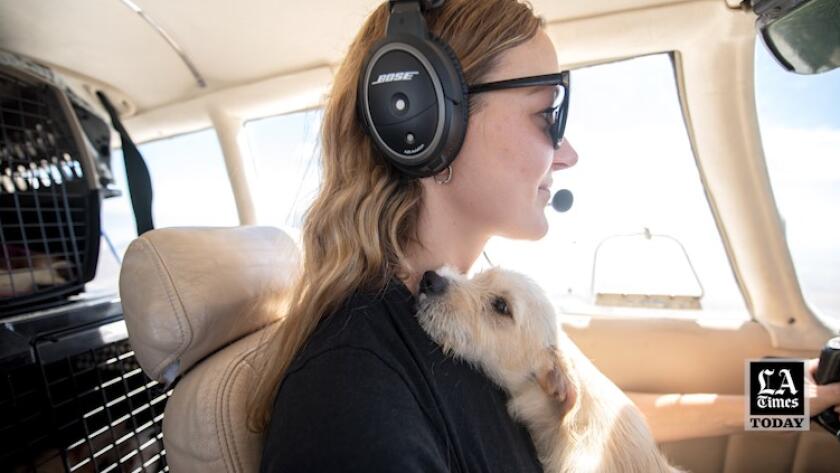
- Share via
Petra Janney nimbly climbs in and around her tiny 1973 Piper Cherokee airplane, preparing the crates inside to hold 17 dogs. She’s confident and clearly in control — she’s flown dozens of flights like these to save dogs from being killed in overcrowded shelters, but she has to move fast.
For the record:
3:22 p.m. Aug. 30, 2023An earlier version of this article incorrectly stated that Petra Janney flies a Cherokee Piper airplane. She flies a Piper Cherokee.
It’s 9 a.m. in late July at Meadows Field airport in Bakersfield, and already it’s pushing 90 degrees. The heat isn’t good for her canine cargo, and it will probably be hotter still when she flies back to Whiteman Airport in Pacoima to turn the dogs over to Laura Labelle, co-founder of the Labelle Foundation rescue in Los Angeles, to provide them medical care and nurturing foster homes until they can be adopted.
She’s in Bakersfield because California has a huge unwanted pet crisis, and Bakersfield feels like the epicenter. Other states have lots of unwanted pets too, especially Florida and Texas, but California has the most dogs and cats coming into shelters — more than 162,000 a year to date — and the highest “non-live outcomes” in the nation, according to the national database Shelter Animals Count.
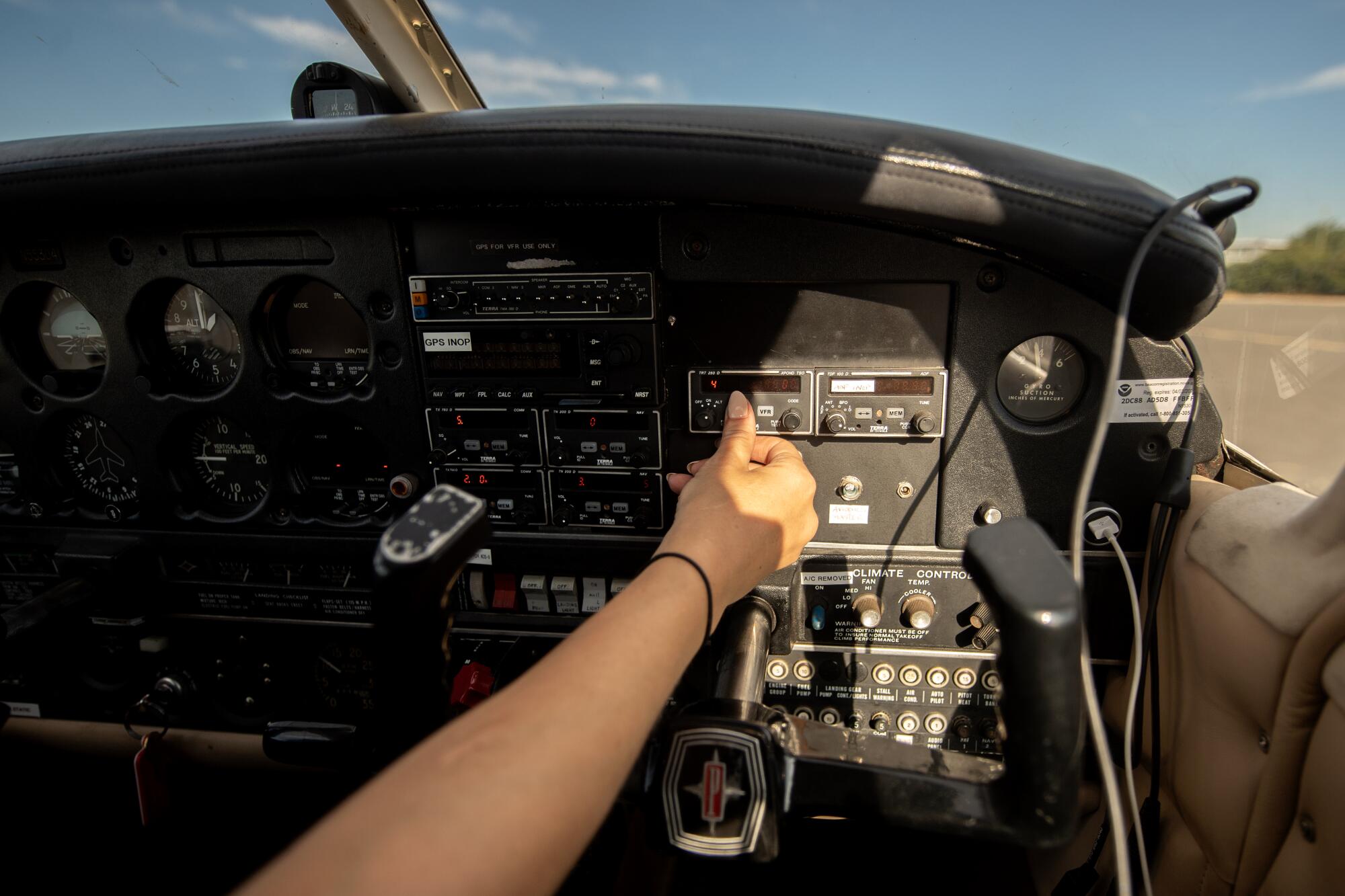
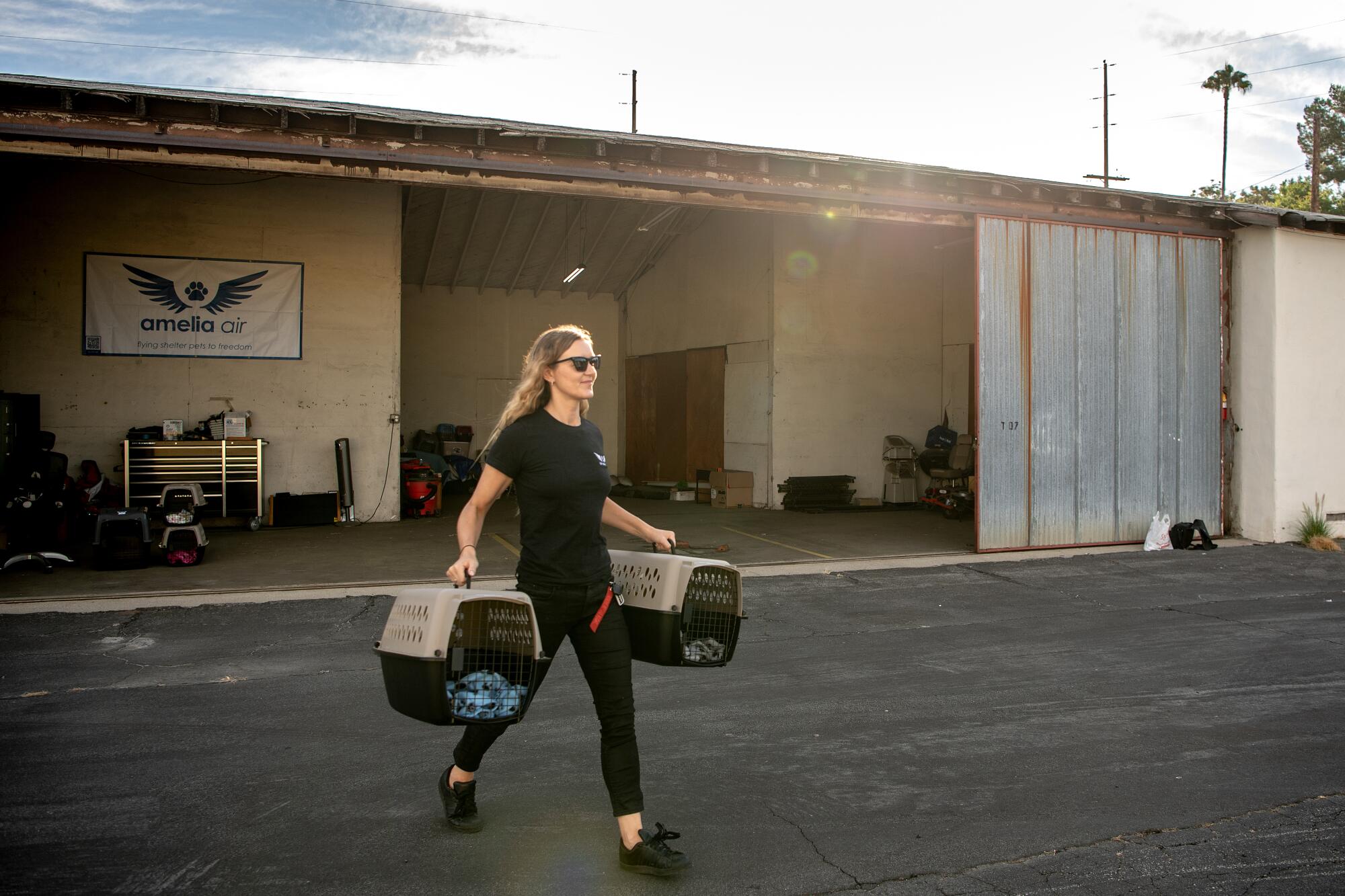
That’s the nice way of saying that around 19% of those animals — more than 30,000 so far this year — died in custody in California, some from illness or injury or despair but most by euthanasia, “put to sleep,” as some call it, primarily because the shelters were out of space. Bakersfield’s Animal Care Center shelter is a case in point. This year, it’s been euthanizing 200-plus dogs a month, according to Director Matthew Buck, just to make room for the 150 new dogs coming in every week.
Transporting dogs out of the area is part of the coping strategy for the shelter. The staff regularly works with rescue organizations in and out of the state to move dogs to areas with fewer strays and a greater demand for adoptions. So there are buses who take bigger dogs up to Washington state, or well-heeled donors who pay for Chihuahuas to fly to Connecticut, where the demand for that breed is high and the numbers low, according to Josh Proctor, the shelter’s transport coordinator.
The Wallis Annenberg Wildlife Crossing over the 101 freeway won’t open till late 2025, but the work of collecting native seeds and building a nursery to grow them has begun.
And today, Janney is doing her part. This trip is costing her at least $300 in fuel and rental fees, but it’s money she’d have to pay out anyway to get the flight hours she needs as a private pilot. That’s the idea behind Amelia Air, the all-volunteer, nonprofit animal rescue organization she co-founded in 2019. Private pilots need regular flight hours to maintain their licenses, so why not put all that time and expense toward a mission?
Amelia Air is small but it operates on both coasts, with Janney in Los Angeles and co-founder Dean Heistad in Washington, D.C. They’ve rescued 1,318 dogs, cats and even a few ferrets since they began — 310 animals (mostly dogs) this year alone, more than half in California.
Amelia Air has a roster of about 20 volunteer pilots nationwide, but in California, Janney flies the bulk of the missions. This is her 12th such flight this year, so she’s all business readying the plane. But now comes the hard part, the guard-your-heart part that also makes it all worthwhile: picking up each dog to safely stow them for the flight.
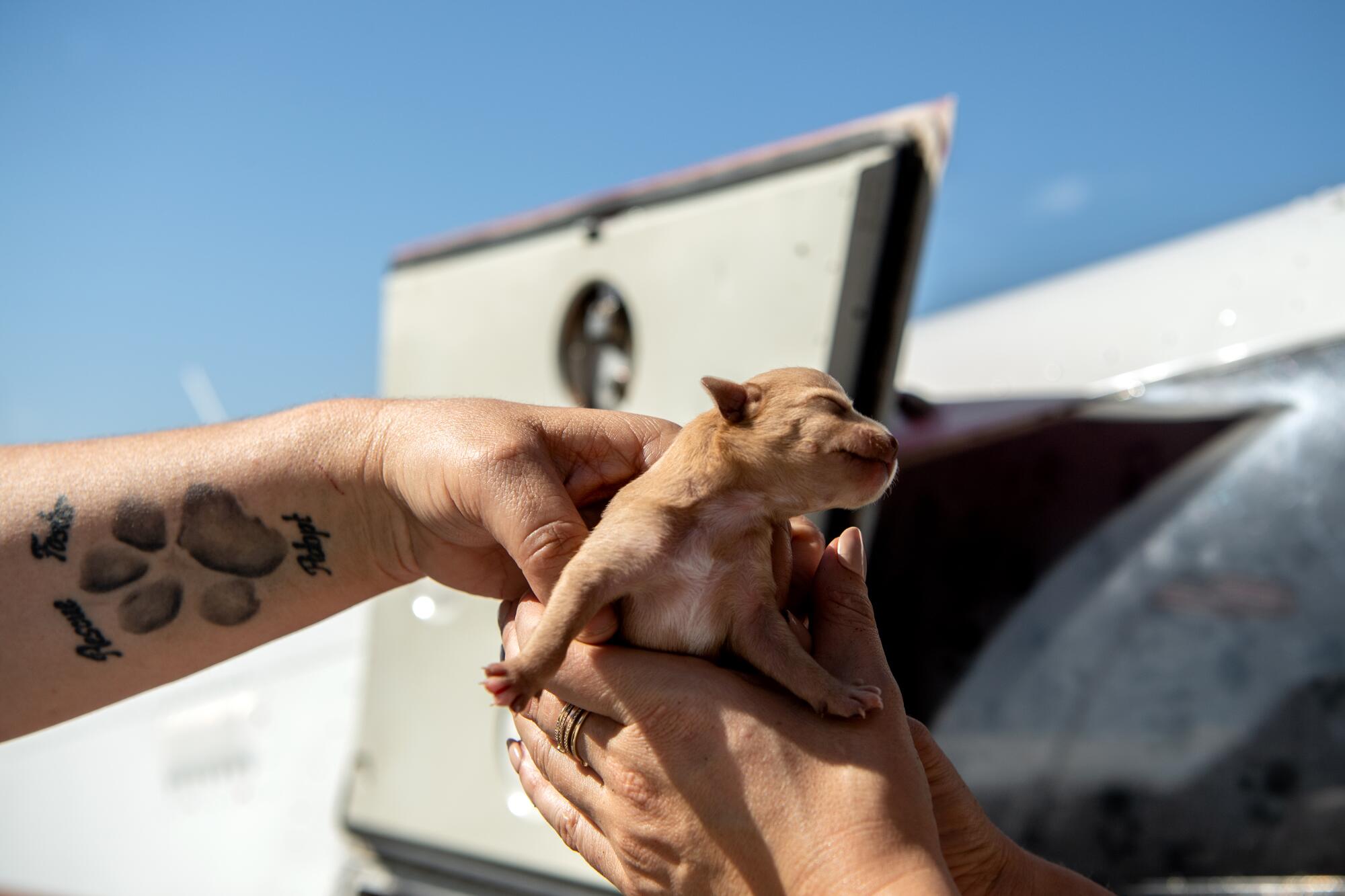
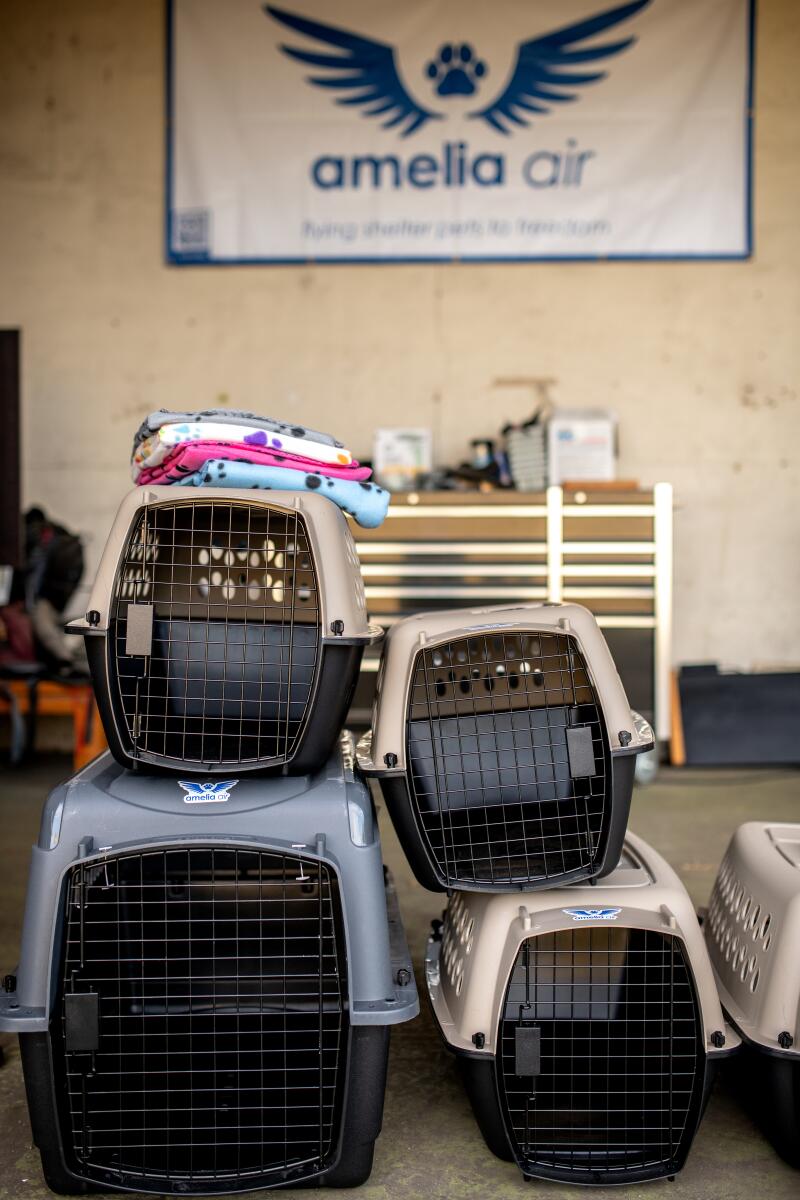
Crates, which will load into the back of Petra Janney’s plane to rescue dogs. (Mariah Tauger / Los Angeles Times)
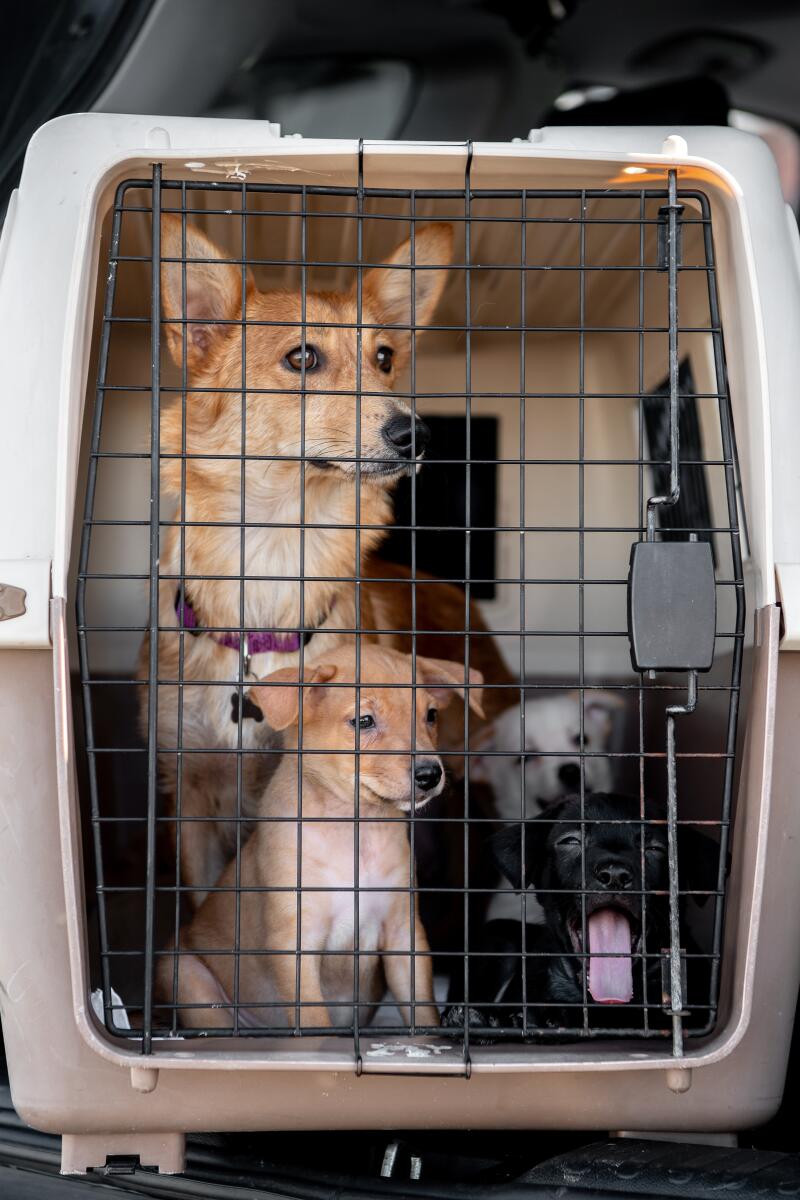
A mother and her pups arrive from the shelter to Bakersfield Jet Center where they will be flown to Whiteman Airport and transferred into the care of the Labelle Foundation. (Mariah Tauger / Los Angeles Times)
First there’s a litter of six hamster-sized newborns, some kind of Chihuahua mix who came into the Bakersfield shelter with their umbilical cords still attached. Then there are four slightly older puppies, pit bull mixes probably, whose eyes are still tightly shut, futilely nosing around the crate for their mother who never made it to the shelter.
These so-called bottle babies are the biggest reason Janney has to hurry, because they can only go a few hours between feedings.
Next is a vigilant, fox-faced mother and her four rambunctious pups, old enough to be weaned. Animal control officers found the mother with six puppies abandoned in a locked crate, says Krystyana Jackson, the rescue coordinator who brought the dogs to Janney this morning. Jackson is part of Unity K-9 Express Rescue, an all-volunteer animal rescue that fosters puppies and dogs who are sick and injured while arranging for permanent placements somewhere away from dog-saturated Bakersfield.
“The puppies were in horrible shape,” Jackson says, “super dehydrated, full of worms and emaciated.” One puppy was dead by the time the officers found them, a second died at the shelter, but a foster family was able to nurse the rest of the family.
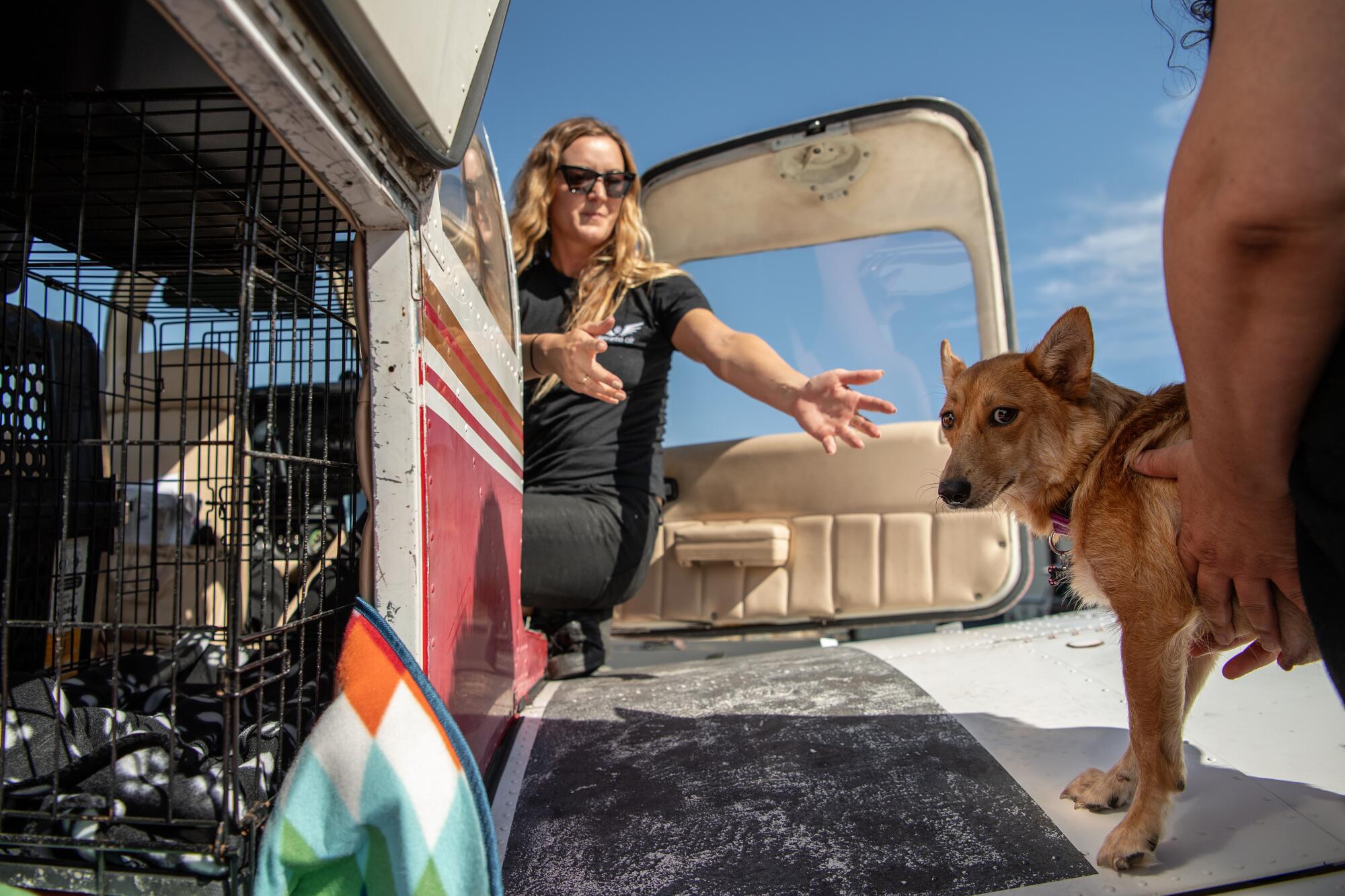
The mother watches quietly as Jackson talks. Her puppies gambol around her, looking healthy and excited, but everyone else seems momentarily stunned by this story. And then Jackson breaks the spell.
“People are evil,” she says flatly. Janney takes a breath and their work resumes.
Once the mom and her pups are in their new crate, Janney is ready for the final two, adolescent wheat-colored dogs who tremble in their cages but melt into the arms of whoever picks them up.
The largest one, a scruffy terrier mix, is last. He leans his head against Janney as she prepares to load him in his crate, and she stops to snuggle him back. She’s taken time to quickly nuzzle all the dogs before they entered the plane, but this guy is clearly special.
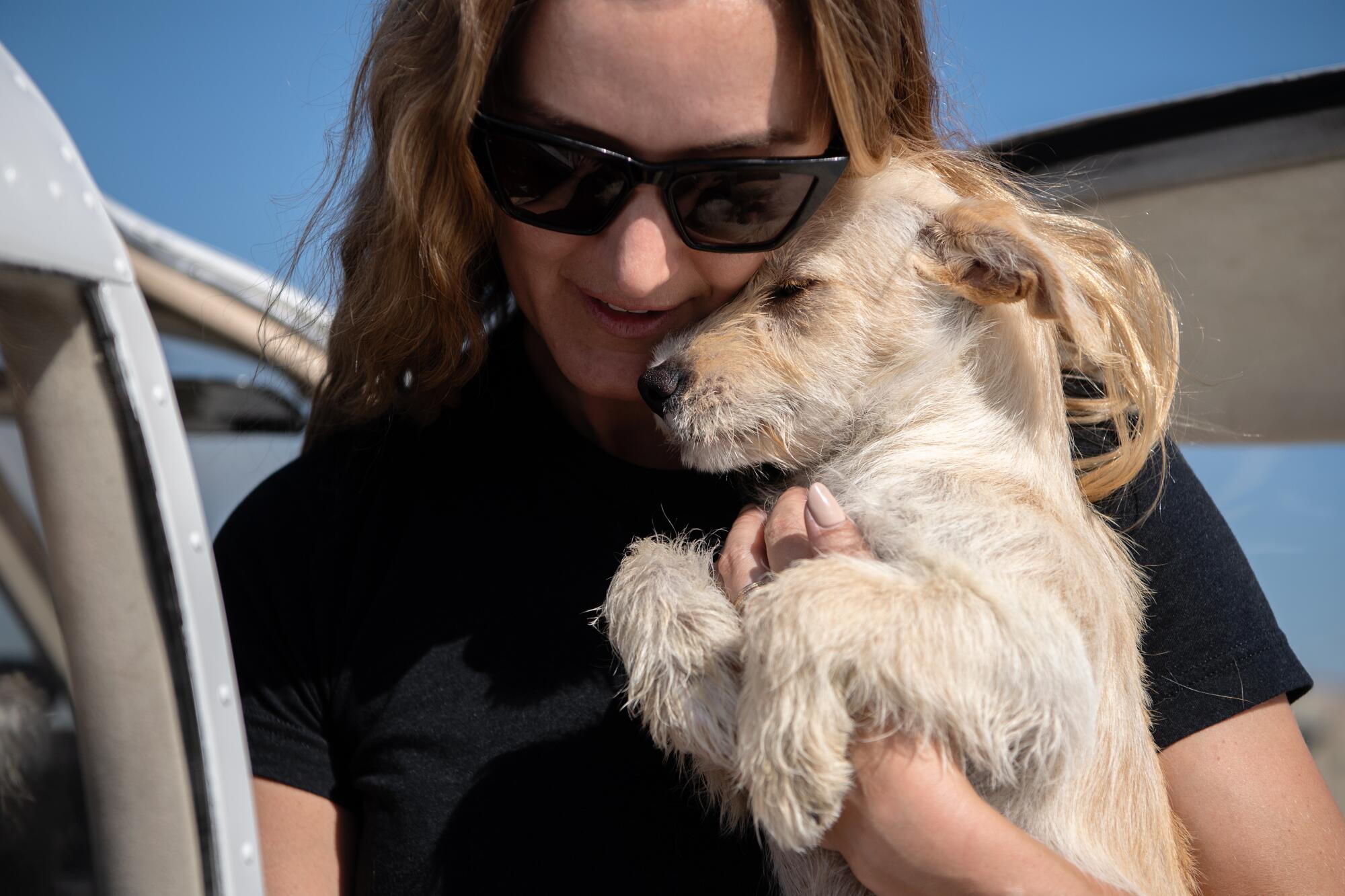
He was a stray, Jackson said, running loose and then held in Bakersfield’s cacophonous shelter that’s bulging with more than 300 dogs this week. The shelter is bursting at the seams, Buck said, and it’s devastating to the staff, who are doing everything they can to get the dogs out alive. More than 4,100 dogs have come in so far this year, 700 more than last year. Its 175 kennels designed for one dog are each filled with two or three or even four dogs.
Paradoxically, adoptions are up by 46%, not surprising since city residents can get a dog spayed or neutered, vaccinated and microchipped, with its own ID tag, for just $20 to cover the city’s licensing fee; or for free if they live outside the city. But still, they have to euthanize.

All the employees own multiple dogs, and then foster more at home — Buck owns four dogs and is currently fostering two more. The shelter even has its own canine herd behind the counter — about a dozen dogs contained by baby gates who were failing in the kennels — in the hope that regular human contact will revive their spirits and improve their chances of finding a home.
The scruffy stray is one of the lucky ones. If he’d stayed any longer at the shelter, he would have been a goner. But here at this airport, far from the shelter’s barks and whines, he sighs when Janney cradles him and closes his eyes, his face a perfect picture of grateful relief.
“I don’t know if it’s all in my head, but they seem to know they’re going on to something better,” Janney said later. “We’re trying to make them see that not all humans are bad people. We’re there to help them be less afraid, and I hope they understand that. Once they’re in the plane, most of them go to sleep pretty quickly. They just take a nap and come out with their tails wagging, excited for what’s next.”
Jana Johnson rebuilt her shattered life by thinking differently and nursing the nearly extinct Palos Verdes blue butterfly back from the brink.
Janney is a pro at protecting her heart. She has two 11-year-old pit bulls at home and no space for more. “If I took home every dog I transported, I couldn’t fly anymore,” she said.
Nonetheless, once the plane is in the air, she pulls the scruffy stray from his carrier and holds him against her shoulder where he lies like a sleepy baby for the 30-minute flight.

When they reach Whiteman, Janney turns him and the other dogs over to Labelle, who whisks them away to waiting foster homes so they can be nurtured and assessed until they’re ready for adoption.
There was a little bond, Janney admits later, but it’s not the rescues she gives up that keep her awake at night.
“It’s the animals we haven’t been able to save,” she said, “the numbers who are euthanized every year. I try to focus on the dogs I save, and not get overwhelmed by the scale of the problem because despair solves nothing. It makes it harder to act. I believe action is the antidote to despair.”
Janney frets that her plane is so small, because animals clogging most of our shelters are big dogs, like those blue-eyed huskies made famous by “Game of Thrones” who were so adorable as pups but as adults have joined pit bulls and German shepherds as the most frequent shelter residents and least likely to be adopted, said Buck.
Despite the overcrowding, California also has the country’s highest number of “live outcomes” — pet adoptions and reunions — due partly to an army of volunteers doing all they can to stay their executions. Some donate time to foster abandoned newborns who can’t stay in shelters because they require around-the-clock feeding. Some cover medical care for animals who are sick or injured. Some, like Janney’s Oscar-winning aunt, Allison Janney, raise money for rescue operations.

And some, like Amelia Air, focus on getting unwanted animals away from overburdened rural shelters to larger population centers with more medical resources and a greater pool of people wanting to adopt.
Janney is a 30-year-old Harvard grad who grew up in Maine, became a vegan at 17 and now lives in Silver Lake, where she co-founded the consulting firm Hatcher to help people create sustainable businesses. But she doesn’t want to talk about any of that. Her focus now is on saving dogs, and she has to steady her voice to explain why it matters.
“I believe we have a crisis of compassion,” she said. “People have become immune to the suffering all around them, so rescuing animals is a great way to strengthen our compassion. It’s probably easier to deal with a puppy than the homelessness crisis, but this helps strengthen our compassion muscle and, when we do that, I believe it translates into other parts of life.”
Janney always wanted to fly, but wasn’t motivated to learn until Heistad told her about his idea for Amelia Air. Heistad was inspired by a flight he and his wife made to rescue a neglected Great Dane in southern Virginia. The dog was dispirited and huge, and they weren’t sure how to get her inside their small Cessna, Janney said. But when the dog saw the plane, she immediately jumped on the wing and crawled inside. As it turned out, she loves to fly, so they named her Amelia, after the great aviator Amelia Earhart.
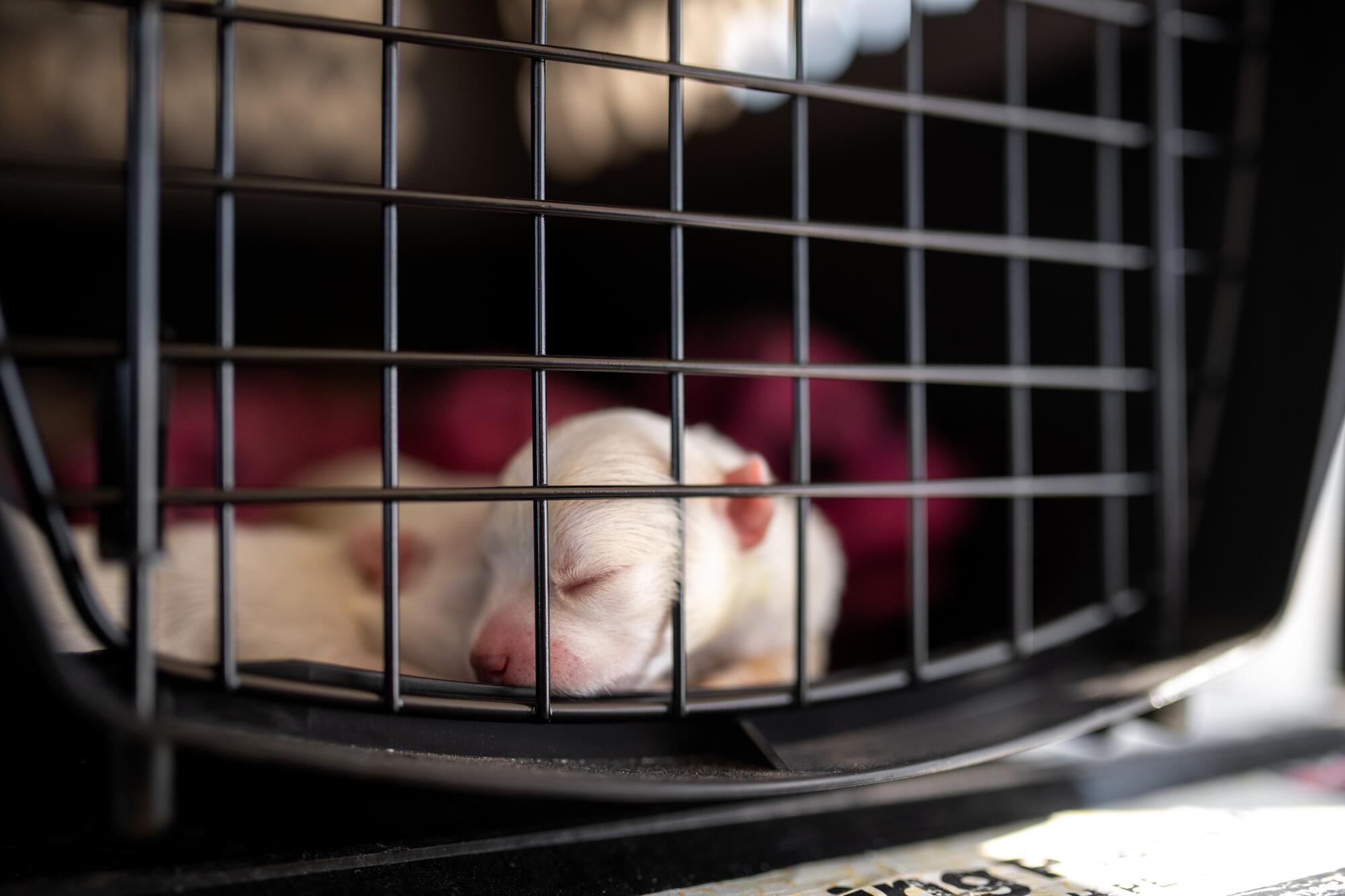

When she heard Heistad’s dream, Janney said she immediately volunteered to do the paperwork to get the nonprofit started, but she also began taking flying lessons, because she wanted to rescue animals too. She started flying missions right after she got her license in February 2020.
Not all their missions have involved pilot volunteers, however. The most memorable happened last fall, she said. Priceless Pets, a rescue in Chino Hills, got word that a pharmaceutical testing facility near Dallas was done with the 45 beagles in its lab. The dogs had been bred for testing, Janney said, lived all their lives in cages, and were going to be euthanized in 72 hours unless someone could find them new homes.
After her rescue dog, Buddy, bit someone, Michelle Madden tapped bad-dog experts for help. Their advice made the situation worse, so Madden had to find another solution.
Moving 45 beagles in that short of time wasn’t possible for tiny Amelia Air, Janney said, but while Priceless Pets secured 45 airline-approved crates that could hold food and water, she called American Airlines to see if they could fit all those dogs on one of their flights from Dallas to LAX.
“They clearly wanted to help and they gave us a very, very good rate, around $9,000 for all those dogs,” she said. Amelia Air, which does regular fundraisers, paid for the transport.
Amelia Air has also started covering the driving costs and medical supplies for one of its pilots, a veterinarian in Louisiana named Adi Chatow who volunteers at rural cllnics in her area to provide low-cost sterilizations. It’s the only way to stop this avalanche of dogs, Janney said, that and shutting down so-called backyard breeders.
“People have to stop buying dogs so people will stop breeding dogs And they need to realize that bringing home a dog is a commitment for the life of that animal. So if you can’t donate or volunteer, at least spread the word. Make sure your friends and family are adopting and not shopping.”
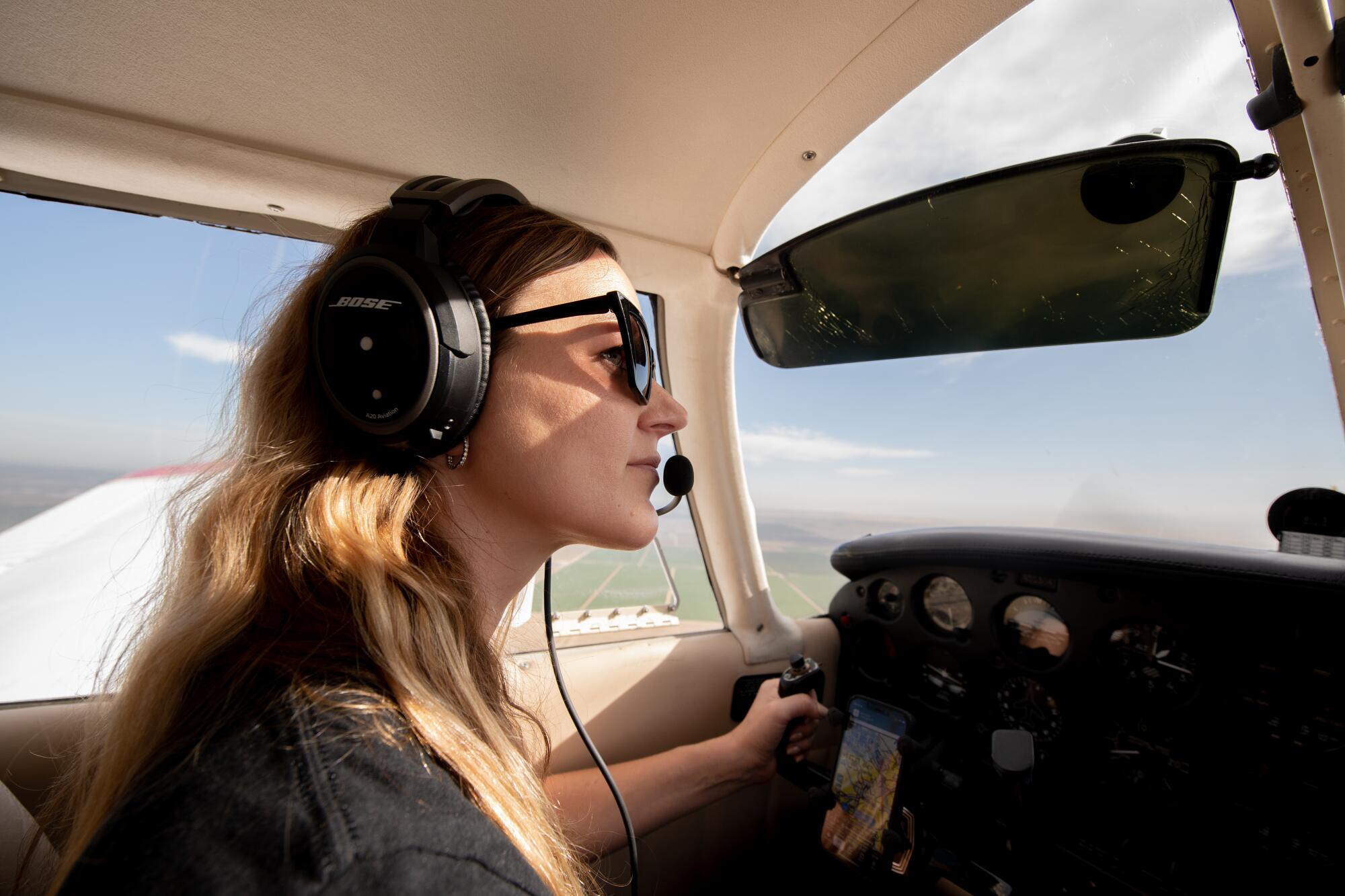
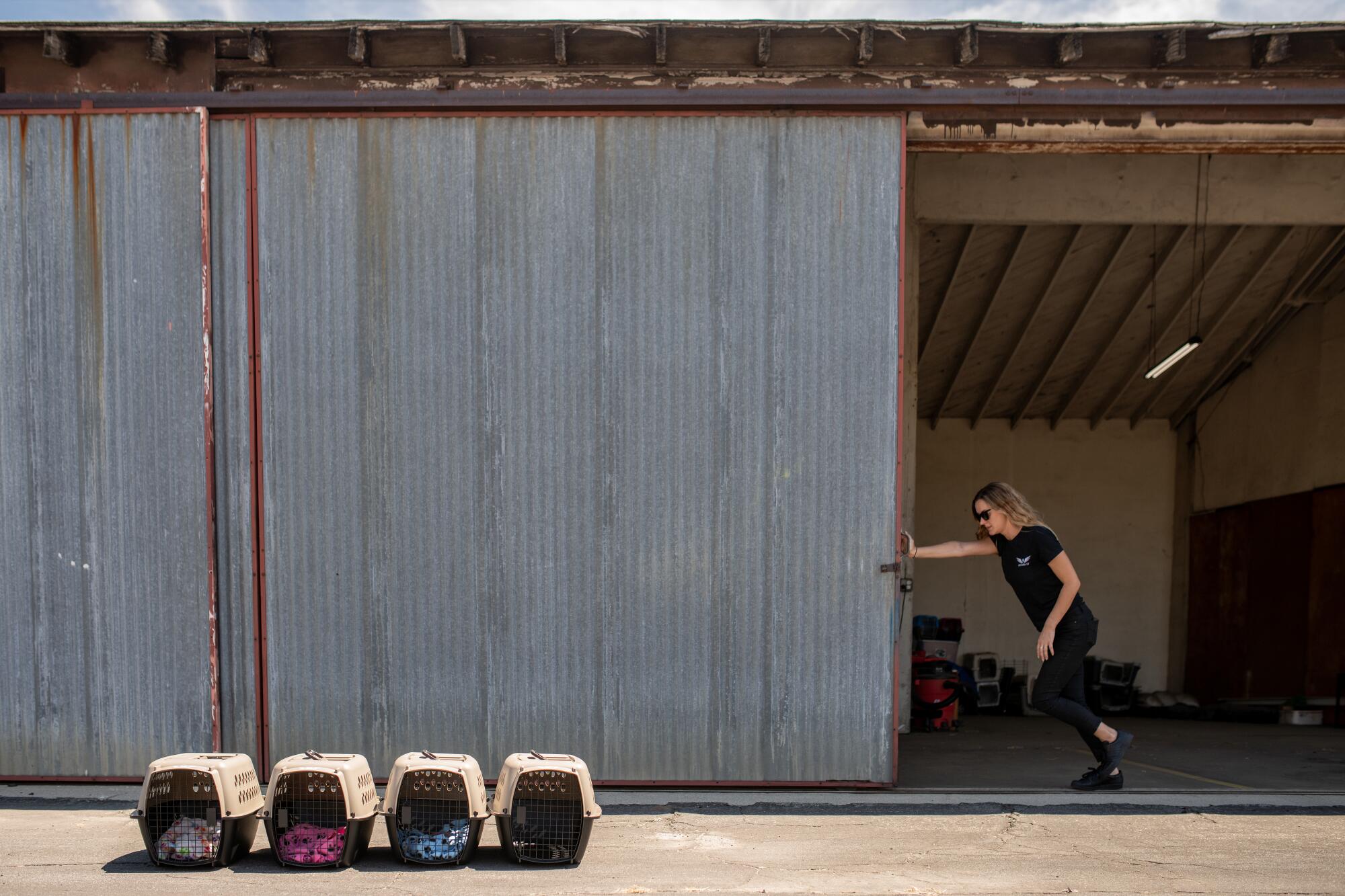
When she gets too frustrated with humans and all the animals being killed, Janney finds strength and solace from remembering the lives they’ve saved.
All 45 beagles made it safely to California, she said, and in less than two months, Priceless Pets had gotten them all adopted. Janney said she was amazed to see some of the dogs nuzzling with their foster families just two days after their rescue.
Is it possible to humanely experiment on beagles (or cats, monkeys, mice and fish)? Activists and researchers disagree.
“These beagles never went outside, they had been poked and prodded by humans in their cages for most of their lives; yet, within a few days, everything was forgiven and they were ready to be with a family,” she said.
“If they can find a way to forgive people, then I can too. I’m not saying it’s easy, but they’re so resilient, they inspire me to be resilient too.”
- Share via
Watch L.A. Times Today at 7 p.m. on Spectrum News 1 on Channel 1 or live stream on the Spectrum News App. Palos Verdes Peninsula and Orange County viewers can watch on Cox Systems on channel 99.
More to Read
Sign up for The Wild
We’ll help you find the best places to hike, bike and run, as well as the perfect silent spots for meditation and yoga.
You may occasionally receive promotional content from the Los Angeles Times.
